Practical Food Storage and Preparing For Price Increases
This post may contain affiliate links. Read our disclosure policy here.
Are you concerned about rising food prices and unsure how to prepare? Here’s a guide to Practical Food Storage to prepare for price increases!
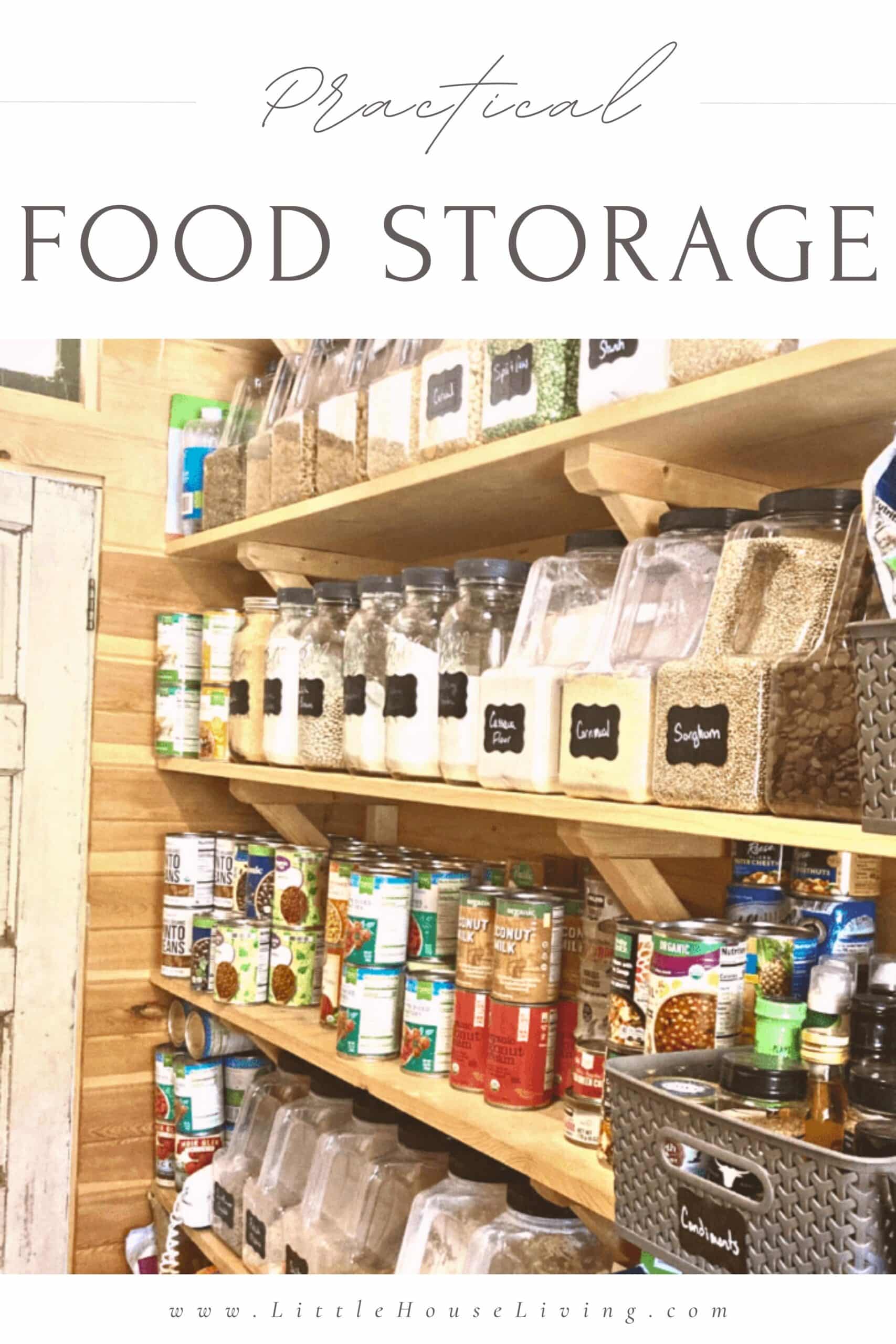
How to Prepare for Price Increases
Have you ever wondered what you would do if the prices of the things that you buy the most, food and clothing, suddenly went up significantly? Would your family survive on the same budget you live on now? Or would they suffer under the weight of the new costs?
Many times, when the prices of consumable goods increase, it’s only a temporary increase. That means that we need to learn how to weather the storm. Of course, we can always focus on long-term help such as being able to grow a garden, being as self-sufficient as possible, etc (Learn how anyone can be more self-sufficient!)
But this article will focus on things you can do for those short-term price increases. This series is based on a series originally posted on Little House Living in 2011 and has been updated. Let’s dive in!
Tip: If you aren’t sure why you would stockpile, check out this article first – Why Stockpile?
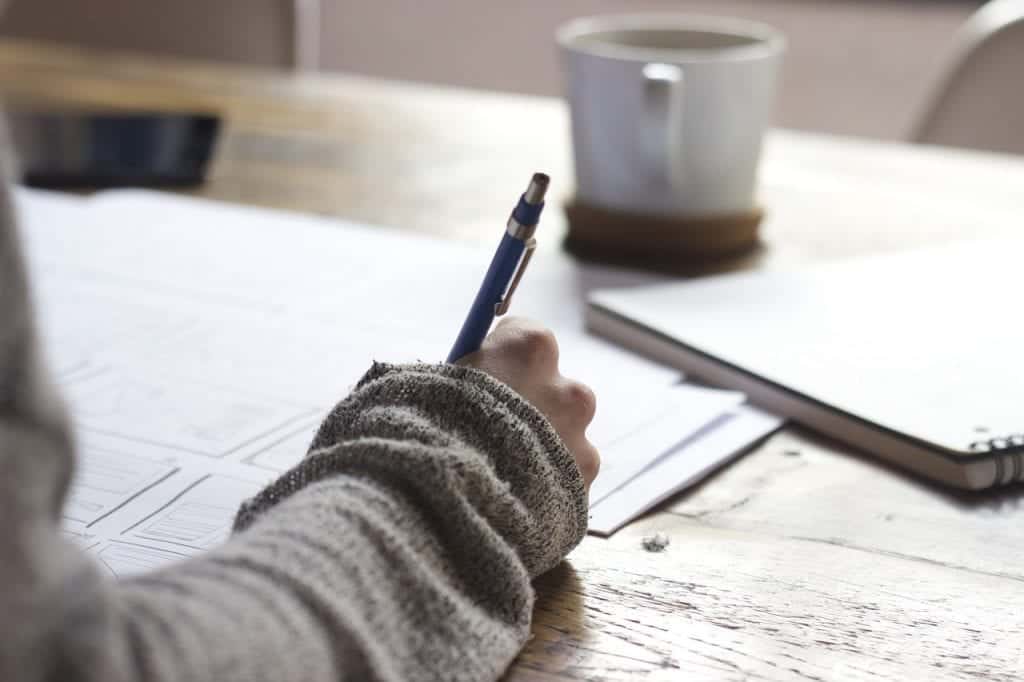
Creating a 3-6 Month Needs List
Before you start your food and items storage, you need to figure out what you will need. The easiest way to do this will be to make a list of what you use.
If you meal plan, this step will be much easier. Look through your old meal plans and figure out how much your family eats over a month. Write down how many pounds of hamburger, how many packages of pasta, etc.
It’s also a good idea to do this with your health, beauty, and toiletry products. I’ve mentioned how I make a How Long Does It Last Checklist.
This would be a great way to easily create your health and beauty stockpile. And don’t just use this method with health and beauty supplies; think facial tissue, toilet paper, and things like that, too.
Don’t think you must have all pantry items for your food storage. Even though having shelf-stable items and items that have a long shelf-life is the most sustainable form of food storage, it’s not necessary to be totally dependable on one form of storage. If electricity isn’t a concern for you, work on your stockpile in your freezer.
Once you have a good list of what you need, don’t feel like you need to buy everything all at once! If you are working towards buying the food items on your list, check out this article on How to Build a Stockpile with $5 Per Week.
Tip: If you want to go even further, check out my tips on building Long Term Food Storage.
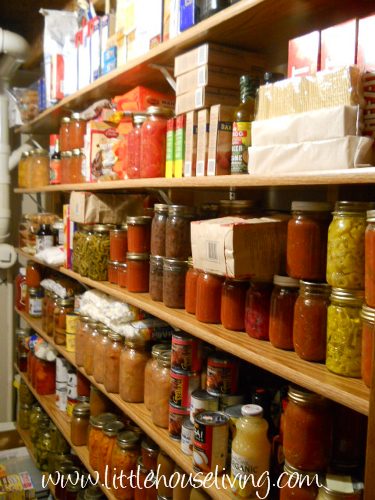
Rotating Your Stockpile
Almost everything expires or goes bad over time. Even if you create a stockpile lasting at least 6 months, you should be prepared to rotate it monthly. Although they claim that some sealing methods will keep food good for 20 years, do you want to have to open a bag of 20-year-old wheat berries down the road?
Me either.
When you put an item in your food storage, you should mark on the package or container what the product is and the date you sealed the box.
Depending on the product, you will want to go through both your food storage and your health and beauty stockpile about once every 6 months or once every year to rotate out the older products and eat them or use them up and replace them with new, fresh products.
Remember, we aren’t building a stockpile here to last through the ages; we are just building a practical stockpile should something happen with the economy or consumer prices shortly.
For your health and beauty stockpile, it doesn’t hurt to write the product expiration date in a large permanent marker so you can read it easily. Make sure this part of your stockpile is sorted through every 6 months to a year, and take out the products close to their expiration date.
Use them up or donate them.
A clean, well-organized stockpile is a happy and efficient stockpile. Things will be easier to find, and you don’t have to worry about wasting money on products that are no longer good.
Tip: Make sure you keep your food protected. Here’s how to seal it away from Pests and Insects.
Whenever you buy a new product for your storage or stockpile, mark it with the expiration date or the packaging date and stick it in the back of the closet, pantry, or wherever your storage may be, and move the current stockpile items up further so they can be used first.
In a retail or grocery store, it’s called facing; bring the older products up to the front so they can sell first and make room for the newer products. Your stockpile is your little local grocery store!
Tip: Knowing how to do your own forms of food preservation can be huge when it comes to building a stockpile. Learn more here.
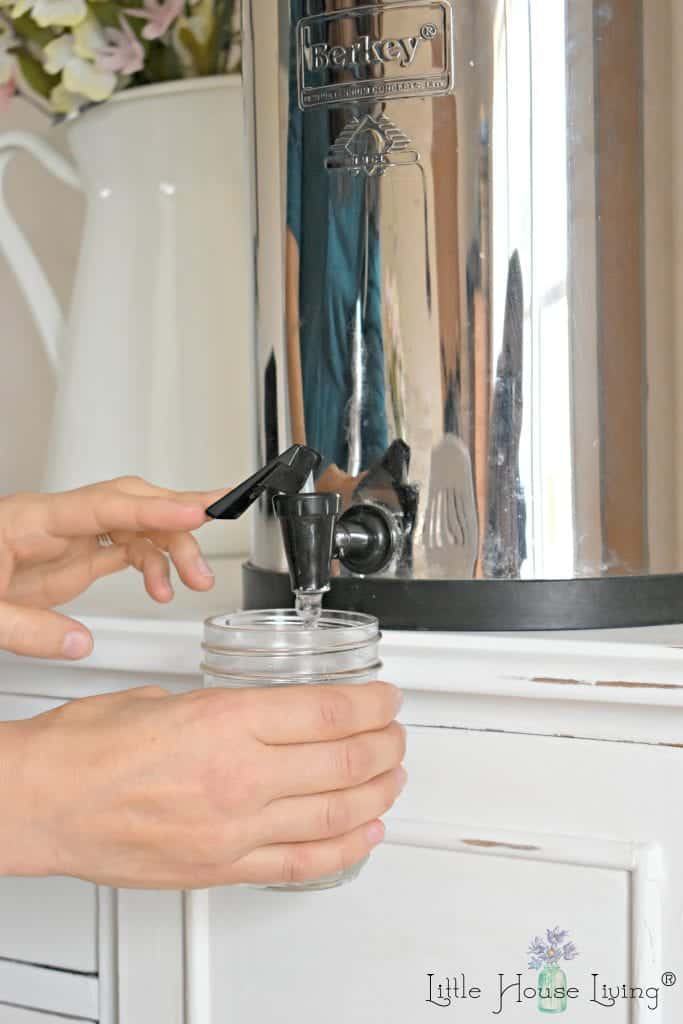
How to Stockpile Water
Something that should be high on your priority list when creating a food storage and product storage stockpile is a water stockpile. Every person needs water to survive, so learning how to stockpile water is very important.
You should store enough water for each person in your family for 2 weeks. Each person should have 1 gallon of water daily in the stockpile, so if you have 2 people in your family, you should have 28 gallons of water.
If this is too much for you (if space is an issue), you should at least have 3 days of water stored for each person at the bare minimum.
Why stockpile water? In case something contaminates your water source, in case you may be out of electricity and your well can’t function, in case bad weather comes and freezes your pipes.
There are many different reasons to stockpile water, each as important as the last. You can read more about our time with our running water in my article on How to Survive Without Running Water.
If it works well for you, I’ve seen large food-grade 55-gallon drums that you can store water in. This may be a good option if you are short on space but still want a decent water stockpile.
You shouldn’t use milk jugs when storing water long term because they aren’t meant to hold liquid long term, and the plastic will eventually break down.
A good way to store water is in old pop/soda liter containers or gallon-size vinegar-type plastic jugs. The plastic is thicker on both (if you order them now, you can get BPA-free, I believe), so they will last longer without breaking down.
You can also get nice water storage containers online that hold more than 1 gallon; some are even stackable!
Store the water in a cool, dark area (like a pantry or a basement) to avoid wearing down the containers prematurely. Be sure to change out the water every month or every other month if possible.
You may also want to consider having a source of clean drinking water if you are planning for a longer term (since you can’t exactly store water to last 3-6 months!). We have been using a Berkey Water Filter System for many years, and I highly recommend it!
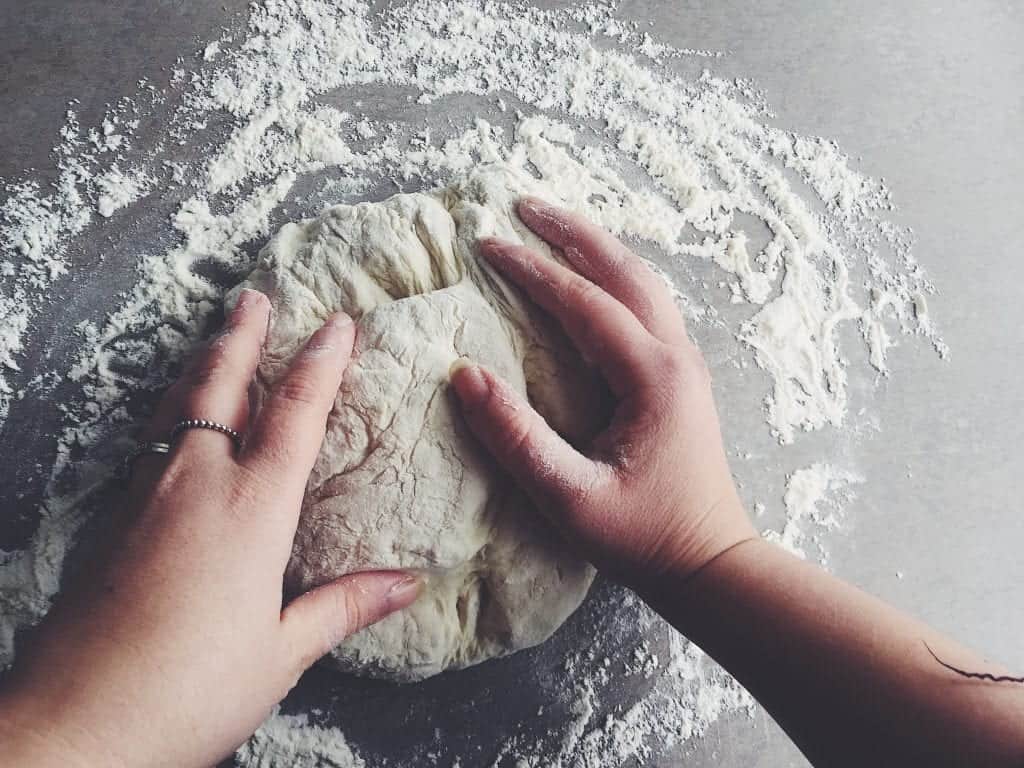
Prepping by Learning Basic Skills
If we assume the prices of everything will rise, and we are learning to barter and more…doesn’t it make sense to know some other basic skills?
These are things that we pay for now, but if we lived back in the 1800s or early 1900’s we wouldn’t even consider paying for luxuries like these! I’m just going to list a few here that I suggest you learn. I’ll also include items you will need to utilize these basic skills.
Remember, there are SO many basic skills that you can and should learn, but in this article, we are just focusing on the very basics…how to feed and clothe yourself for a short period.
Baking
I’m surprised at how many people don’t know simple bread-baking skills! I think it’s because I grew up in a bubble; my mom made bread, and my grandma always made bread.
Even though I knew you could get bread from the store, I thought it tasted nasty. Bread baking is a skill learned best by being shown by someone who knows what they are doing. After you get the hang of it, it’s not that hard!
I can guarantee you that your first loaf won’t be perfect! I remember years of 4-H judges telling me what was wrong with my bread…now my hubby can’t wait for me to pull it out of the oven so he can munch on it like candy. Being able to bake is a very good basic skill to learn.
Here’s my Basic White Bread recipe to start practicing with.
What are some items you should stockpile to be able to utilize your baking skills?
- Yeast. Get the already vacuum-sealed packages and when you open one, put the rest in the freezer to keep it good for a long time.
- Flour, sugar, salt. Basic baking foods.
- A good bread pan or baking sheet. I recommend stoneware.
Sewing
I’m even more surprised at the growing number of people who have no idea how to sew. I didn’t go to public school in high school, so my husband had to inform me that they are no longer teaching Home Ec!
I am not the best seamstress, but I’m glad I have the skills. I use it to sew up rips and tears in otherwise perfect clothing. I have a sewing machine, but you don’t need one to be prepared.
Get thread, needles, and some felt or thicker fabric, and start practicing. Look up some videos on YouTube if you need some visuals, or buy a basic sewing book. You will catch on fast!
What are some items you should stockpile to be able to complete your sewing skills as needed?
- Threads, several colors.
- Needles, various sizes. (Dollar store!)
- Scrap fabric for patches. (Learn where to buy cheap fabric here.)
- Good scissors.
If you are learning other essential skills, don’t forget to stock up on what you need for them! I love to crochet, and I make all my own washcloths and dishrags out of cotton yarn; when I found out the price of cotton was going to go up, I started stockpiling my favorite 100% cotton yarn so I could continue making dishcloths for us. It’s wise to plan ahead when you are able!
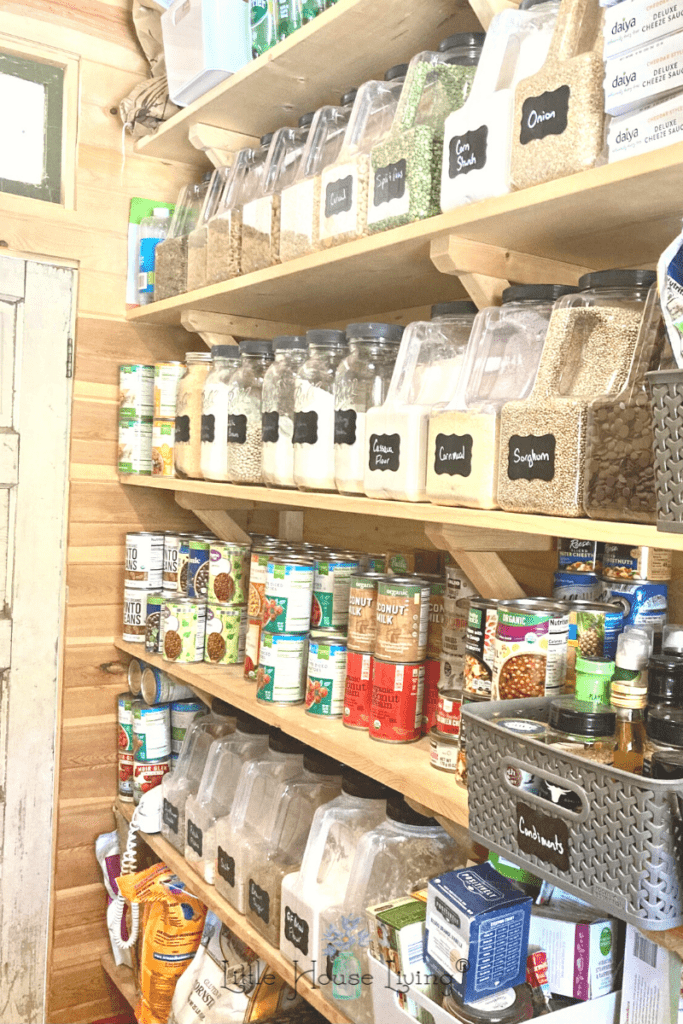
Extra Tips for Practical Food Storage
Don’t buy in bulk if it’s not something you use. Or don’t buy in bulk if it’s not something you can use up before it goes bad.
If you have large quantities of something, consider putting it in long-term storage until you can get to using it.
Not sure what to put in your practical food storage? Here’s a great list of Basic Foods to Stockpile in a Pantry.
It’s very important to keep your food storage protected from moisture and pests. There are plenty of containers out there to store food in, such as 5-gallon buckets, glass jars, and more. Here are my favorite Food Storage Containers.
If you want to create cold storage or make the most use of your cellar, here are my ideas on DIY Cold Storage methods.
Only have a tiny pantry? Here are some Small Pantry Storage Solutions I’d recommend checking out.
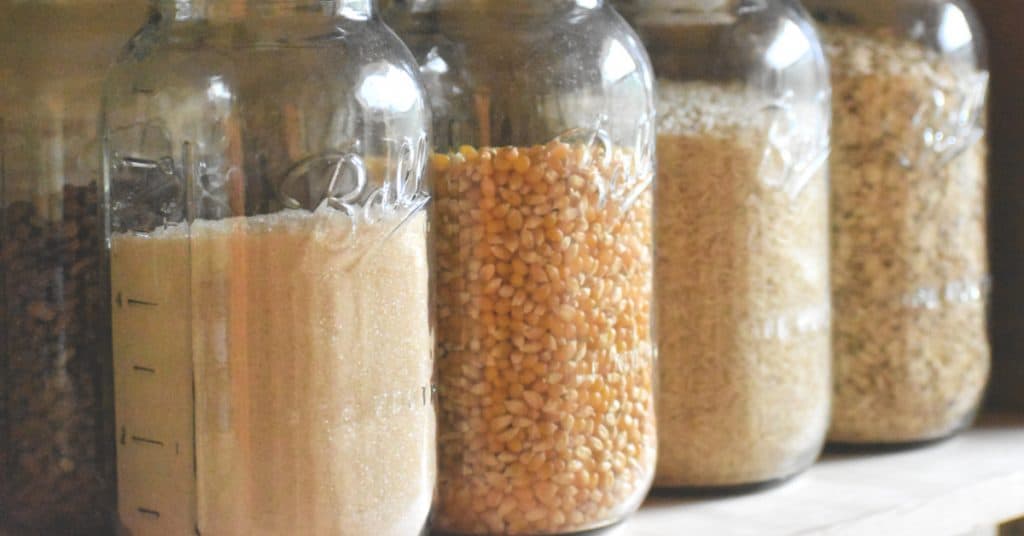
Basic Foods I Recommend Storing
I have many articles on how to build a proper stockpile and a well-stocked pantry but if you are still unsure where to start, here is a list of foods.
- Lentils and Dry Beans
- White Rice
- Pasta (spaghetti and other shapes)
- Jams and Jellies
- Peanut Butter (or other nut and seed butters)
- Oats and other whole grains
- Canned Chicken, Beef, or other meats
- Canned Tomatoes
- Canned Vegetables (carrots, green beans, peas, corn, etc)
- Potentially freeze-dried foods (aka survival food, although this really belongs in long term food storage or an emergency food supply)
- Any other high-nutrient foods that your family enjoys (protein powder, soups and chili, etc)
- Crackers and other shelf-stable snacks (chocolate! cookies! pickles!)
Common Questions About Food Storage
A 3 month supply of food for a family of 4 should have 1080 servings of food. That’s 3 meals per day for each member of the household for 90 days.
To stockpile food for a year or longer, you need to use some long-term food storage methods. I would also recommend having some cold storage.
The best foods to stockpile are ones that your family will eat. Anything that has a long shelf-life and is something that your family will eat is the food that you should stockpile.

Hopefully, this article has given you some ideas on creating practical food storage solutions for a short-term issue. Whatever your reason for prepping (natural disasters, job loss, economic downturn, zombies), if you prepare in advance, you will be better off.
And if it turns out that you don’t need to utilize your stockpile like you think you would have to, at least you had practice building emergency food storage and can take off a month or two from buying groceries.
Want to learn even more about Stockpiling? Be sure to check out my page on Stockpiling here!
What ideas for practical food storage can you share with us? Do you consider yourself a prepper?

Merissa Alink
Merissa has been blogging about and living the simple and frugal life on Little House Living since 2009 and has internationally published 2 books on the topic. You can read about Merissa’s journey from penniless to freedom on the About Page. You can send her a message any time from the Contact Page.
This article on Practical Food Storage and Stockpiling Water was originally posted on Little House Living in October 2011 as a series of articles. It has been updated as of October 2023.
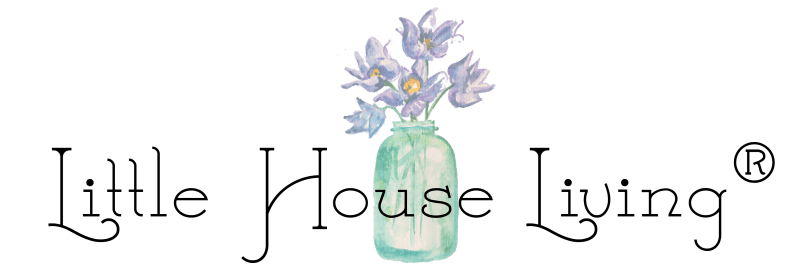
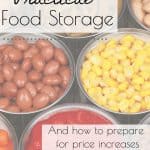

This is something I definately need to work on. I used to have quite a stockpile. I never planned it out though. I just bought things we used on a reg basis when they were on sale (kept up w/sale roataions) and put them in the pantry. It was a hug blessing when we lost or house. We lived off of that pantry with minimal supplementation for close to a year. I need to be more organized now because we have food allergies to gluten now. Looking forward to doing it this way.
We store water for flushing toilets in 5 gallon gas cans. We have had them for at least 15 years and they have never leaked. This time of year you can sometimes buy apple cider in gallon glass jugs. I have 10 of them that I keep drinking water in. That 55 gallon drum looks great but the price is what put me off of that 🙂
I used to get those 5 gallon water cooler jugs with lids. Such as “Poland spring”
Kept one next to each toilet. Only had to use a few times but it wasn’t in the way and I was soooo glad to have it when we needed it!
How long can you safely store well water in a 5 gallon water jug? (The kind that go on the coolers at the office) Is the storage time different if you use RO purified water?
I would change it out every 6 months or so just so it stays fresh. And I’m not sure on the purified water, hopefully someone else knows!
Debbie-we have well water too and I find it gets moldy after a few months. You can put bleach in stored water to keep it longer but I don’t remember the amount per gallon. Those 5 gallon jugs of purified water is a good idea but I wonder about chemicals leeching out of the plastic–anyone know that?
What about water jugs that you get from the store that had water in them to begin with?
Those are ok for a very short term storage but the chemicals from the plastic starts to leach after a few months so they aren’t recommended to refill.
I’m going to be installing a rain barrel next to the house gutters. It is a great way to water the plants but in dire circumstances, the water could be boiled and used for othe purposes.
Love this series! Actually all of your series have been educational & inspirational :-). I was wondering about storing water. If I buy gallons of water, is it okay to refill them with tap water (city water)?
I think it’s fine but I’m not 100% sure since I actually have well water…I know that you can always add a certain amount of bleach to purify the water when you need to use it but the thought of drinking bleach is scary to me so I’d rather boil the impurities out or buy a quality filter. (like a Berkey)
My great aunt & grandma would write the expiration date (or date purchased) & the price they paid on the top of cans with permanent marker! When I was little I thought it was strange, but now as I am older I understand why! Smart ladies 🙂
That’s a great idea!
I was going to say the 3 that you listed! I think learning to sew teaches you so much more than just sewing..fabrics, what to wear with what..go sit down at a pattern book & you will see what I mean. Cooking, of course..it is so much better to eat homemade foods, seriously. Gardening..you can grow your own food. Canning. Basically, I feel just learning to be a little bit experimental & to try new things..you never know what you might like, or like to learn! 🙂
Cooking from scratch! Seem that every time I go on the internet looking for a recipe it includes ingredients like seasoning packets and that nasty cream soup from a can. What happened to being able to cook a meal from basic ingredients that you have in your pantry and spice cabinet? This is a real pet peave of mine right now! I think couponing has made this much worse as all those convenience mixes have been so cheap for so long. We have forgotten what real food tastes like!
Hands down YES! I forget about this sometimes because we only eat from scratch and we have for a long time. My hubby reminds me though when he comes home sick from going out to eat with co-workers. His stomach can’t handle the processed foods any more!
i agree. Allergic to gluten makes me read every label. I can’t eat any of that now. It has to be from the spice rack and the garden. I have old cook books I still go to for inspiration. They don’t mention caned soup at all.LOL
Great thoughts! I know I didn’t have much in this article compared to all the basic skills I think everyone should know but baking provides food for your family, sewing is all you mentioned above, and cutting hair, well trust me that one makes you feel like you can do anything!
I would think another one would be learning to garden, can, and learning about herbs. Medicinal herbs are so good for you.
Yes! More very good ideas!
How about making your own cleaning products and mixes.
There are some great “recipes” online. Or you could go really back to basics: vinegar, borax or something similar, lemon juice. Mix any of them with a little water and your good to go! 🙂
Salt and/or sugar make great cleaning scrubs. As well as vinegar and lemon juice. Newspaper for cleaning windows. These were my grandmother approved cleaners.
Knitting or crocheting are both good skills to have and can also provide you with a little extra income or give you items or a skill to barter with!
Have I mentioned how much I love your blog?
Missy, I always thought the best place to get thread was Walmart but then I realized it’s much cheaper at a fabric store with a coupon or a sale. My good hair cutting scissors I got at Walmart, I think they might be Sally Hansen? They are nice and sharp. Yay for 3 bread pans! I still just have 2 but mine are both stones, I’d really like to have 4 someday since my Bosch can make some large loaves!
So, I used to be one of “those” people that did not really make anythin from scratch.. My idea of baking was slice and bake cookies. Everyone stop laughing. lol When I met my husband and dated and then we became serious he started teaching me how to make things from scratch. Before his mother passed away, she made sure that her kids knew how to cook. He says the best dish I ever made for him was a baked fish dish, which is hilarious because I wore gloves and could not taste it since I am deathly allergic to fish. I now can cook and bake pretty much anything that comes up and have created a few recipes as well. This is such an invaluable resource to be able to cook. We also have saved so much money.. I also learn so much from your site, so thank you very much!
Do you know of any videos out there for crocheting? I want to learn and don’t know where to start! Thanks!!
You can learn anything on you tube. I have learned crochet as well as loom knitting on you tube.
Also, I completely stopped buying processed breads from the store. I make everything homemade breadwise and I make most of my food from scratch too (occassionally I have to cheat with karate and art classes falling on the same night) however 90% of my food is homemade. I can’t stand processed food. It tastes horrible. I want to start getting more into crocheting and knitting, but have no idea where to start. Thanks for any direction out there!
Quilting, this used to be a time honored fun girls day out activity. Lots of socializing involved and you started learning as soon as you could maneuver a needle. Raising your own animals & butchering them. Nobody wants to know that their food had a face. They’d rather close their eyes and just imagine that the food magically appears on that styrofoam plate. They don’t want to know that it had to die or how it managed to live as long as it did. Making firewood and heating your home solely from wood heat. You don’t know how much work it takes, or how much satisfaction you get out of doing these basic skills, until you try them. We’ve all traded in basic skills (formerly essential…maybe soon to be essential again if the power grid goes or economy really fails…)for learning one or two skills well. Won’t do us much good to work our lives away in an office while our children grow up without us. These skills bring families together in a way that our society has forgotten.
So true! I used to be one of the “office people” who couldn’t do anything. After I closed down my business, I started exploring all sorts of ways of increasing our independence from “the system”: gardening, sewing, making my own cleaning supplies, cooking from scratch, canning, dehydrating, and now I am exploring fermenting. I don’t have any kids – personal choice – but I feel so much better prepared for “real” life outside of a city environment. And nothing beats the sense of accomplishment and satisfaction when you know you can and do things on your own! 🙂
oh my goodness, public school taught me nothing of self-sufficiency. we did have home ec but they don’t go into detail about most of it, and they don’t demand that children pay close attention – just get thru the class, do what you are told so you can move on to bigger and better. it’s sad. I am determined to learn sewing (this year) and gardening, as part of my families move to simpler living.
if there is a store that sells sewing machines near you (not wal mart) but a real store that sells sewing machines they usually have lessons on how to use it and classes on starting out sewing. once you start with the basics you can make anything .
I learned to quilt about 10 years ago and when I started, I was determined to never purchase another blanket again. I purchase 100% cotton button up shirts from thrift stores, save all the buttons, rip out all the seams and cut 2″ squares out. When I have enough, I stitch up a quilt top for next to nothing. I’m recycling the shirts, while bringing beauty to our home. Quilt shops now charge about $9 – $12 per yard for their fabrics, which is something I refuse to do now. If anyone is interested in quilting, the best book out there is called “Quilts Quilts Quilts”. You won’t be sorry you invested in it!
Who is the author?
I LOVE LOVE LOVE your blog!!
I beleive the amount of bleach per gallon of water is one bleach lid full. Can anyone out there verify this?
I think I’ve read that it’s only a capful per 5 gallons.
I just read that is is an 1/8th of teaspoon per gallon of water according to gov website. Someone posted it in another blog post.
I had some leftover tiles when we remodeled our kitchen (16″ square I think). I keep one in the oven as a pizza stone and use another to roll my bread and biscuits on. Its a cheap baking stone and works pretty well. Just make sure you clean it thoroughly.
I store flushing water in empty bleach bottles. Clearly marked “For flushing. NOT drinking”.
If you are going to store water in the basement or garage do not store the container directly on the concrete. You can google the reason but basically the chemicals from the concrete migrate toward water and will contaminate your water. If you are going to store water in a basement or on a garage floor you must put a barrier between the concrete and the water bottle. Most people lay down 2 x 4’s and stack the water bottles on top of the 2 x 4’s. You could also store it on a shelf above the floor.
The best way to ensure proper bleach to water ratio is to use a pool tester it should be 1 to 3 ppm of bleach. The exact amount per gallon is hard to determine since there is a clear difference from tap water to well water and one water plant to another. Measure it out as you test it on several gallons then you should know for future reference. Also if you are using a different water source (say you move to a different place) you will have to start from scratch since different locales use different amounts of bleach in tap water. There are also products out there that help prolong water storage up to five years a simple internet search will bring up multiple results.
I use the five gallon food grade buckets you can get at lowes for five dollars. They are strong and sturdy enough to stack and will never leak. Much cheaper way of storing water to make life easier I have a extra lid with a hand pump secured in to it to get the water out and when one is out I just switch the lid.
Please make sure to rotate your water. Easy way of doing that is every time you change your clocks for day light savings time change your water. My family and I use the stored water first before refilling them.
This came in handy last week when Toledo Ohio had our water contaminated with HAB everyone was running around trying to find water driving hours just to find out that the stores were sold out. The national gaurd was called up to help supply water to the unprepared. Please don’t be one of those.
I just thought I would add that for emergency water we bought for around $10.00 or less at Walmart, the blue water jugs used in offices. The water tastes good and kept a long time and there are several gallons each or smaller ones are available. I was impressed with the keep time. Anyway, I had bought one just in case, though no major disaster hit, we did loose power for a week or so. This water came in handy for cooking and what not. Pool water was great for flushing and washing.
I love those blue containers, we have several of them!
Hanging clothes on a line. It’s something that pretty much NO ONE does any more. And those I do see doing it doesn’t to it correctly.
I’m in high school right now and not one school in my district even has a home ec class anymore! It’s really quite sad.
When my daughter was 10 we visited my mother ( she lived in another town) at Thanksgiving. She showed me a box filled with quilt blocks. She had made a quilt for each of her children and also grandchildren, with the exception of my daughter. She was the youngest grandchild and the box of blocks was intended to be her quilt from Grandma. My dear mother lamented that she was afraid she wouldn’t have it finished before she passed. I put that stress out of her mind by promising to get it put together and quilt it. I told her it would be even more special because both our work would be in it. I took the box home and sadly, my mom passed the following March. I took a class in quilting, and ended up assembling the quilt and hand quilted it. That was 36 years ago, and my daughter cherishes it.
Thanks for information about water storage and how I can better rotate and label my pantry. I have been pretty busy with living at home Community College students, son’s wedding and a sick dog.
I have done pressure canning for many years,which is rewarding ,I decided near the end of 1999 with everyone full of fear,I would pressure can water in 1 & 2 quart jars as a precaution ,we had it on hand for a long time & never used it eventually threw it out ,But am sure it was ok.
I think that learning about fermenting foods is a really good skill. It’s so healthy and also such an easy and cheap way of preserving food. I love your site, Marissa, and I hope everything is going well with your new place. God be with you, Caroline
I just started to dive into fermenting foods last summer and I really love it! I hope to do a lot more this year.
I think another important thing to prep is seeds. You can save your own seeds if they are heirloom seeds and expect them to grow true to parents. You never know when our food supply chain will be in danger. I also made sure I know how to knit socks . I also crochet, and sew. I am amazed by the young people today that can not even sew on a button or hem pants.
I have a great bread recipe that allows you to use the dough as needed. I have been using it for years now and, while it is nutritionally not the best, it is incredibly convenient for smaller households, which may not know what to do with all that bread all at once. 🙂
You’ll have to convert the measurements to imperial as we use the metric system.
1 kg Flour
20 g Salt
22 g fresh Yeast (here it is sold in refrigerated cubes)
650 ml Water
Mix everything together as you would normally do with bread dough. Then, leave it in the refrigerator for 12 hours – I prepare the dough in the evening and then let it sit overnight. After 12 hours, the dough has done most of its rising and you can use the dough in quantities you need as you like. On Sundays, I make rolls using roughly 100 g of dough per roll. The dough can be used like this for up to 1 week after the initial mixing.
Enjoy!
My grandma would can water with her regular canning if she didn’t have enough jars to fill the canner up. And easy back up of drinking water.
I came across prepper sites years ago. I have always been a gardener, canner and have always liked buying food. Therefore I always had plenty for the family. They are all gone but I still enjoy buying foods and only on sale for the most part because I have my own little store in the basement. I don’t have to buy anything at all. I have several shelves that I put all this food stuff, and kitchen and bathroom stuff on. Each year I start stacking on new shelves and keep using the earliest and earlier shelves daily. No need to worry about sell by dates for me. I do my own baking and make bread by using recipes that require no kneading. Just mix, let rise, punch down, let rise then bake. I stock evaporated milk, (2 cases a year) to use in coffee and to make ice cream and I can even make butter if I beat it past the whipped cream stage. Or just use it as whipped cream. I dehydrate different veggies I grow which is most of them and powder them together and use them as a health powder in cereal, bread, meat loaf, soups, etc. Actually, I use that powder in all sorts of things. I am getting so many veggies in my diet I believe it is why I never get sick. I am up in age and still, I don’t get sick. I freeze some, I can some and I use no poisons. Years ago I figured it all out. I pay attention to weather, politics, prices, trends, pandemics, how much things cost, how long things last and so much more. I started thinking I have these few acres mostly in forest but enough clear where I could grow so I planted fruit trees, berry bushes and made a large garden. I planted asparagus and herbs that would come back every year ago I wouldn’t have to worry about bad growing years because there would be something and then I got to canning and freezing as on it went..Someone just told me I am a pioneer woman. Well, why not. They survived. I plan on it as well. I used to frequent thrift stores a few times a week I bought appliances I used from them. A 1.00 new toaster and 50c clothing. I still have a walk in closet full of it because when the pandemic hit and I was home all the time I decided to wear only 7 outfits and some jeans. It is 3 years now and the tops are only just showing wear because I wash in cold water. I bought all old manual tools for building, mechanics and household from thrift stores so no matter what happens I can deal with it. Now all of that said and many more things I could add but will not I do like the finer things in life. I do like having lazy times and I do enjoy movies and some tv. Therefore I buy paper plates and towels because doing dishes is the one thing I hate the most. That might be because of two things. I was raised in diners and restaurants and boy there were a lot of dishes, pots, pans, grills. The other thing is I used to sell thousands of jars of pickled foods and jams etc at 4 Farmers markets with the foods I grew in the earlier days. All those huge pots, jars, clean up of kitchens etc. made me know that if I was going to do anything to pamper myself it would be not to have to wash dishes. I steam assorted veggies together in one pot, I saute” them in my iron frying pan or boil them in my pot or air fry them but not often. Yes, I have a small air fryer.Therefore I cut down on the pots. So, there you have it. The woman that just got called a pioneer woman and just a few bits of what you can do to care for you and your family. I guess I was lucky in that I figured it all out when things were dirt cheap and knew what to do about it to care for myself well when the time came and I was alone. I hope only the best for all of you and I hope you think about the future and prepare, well for it. Hugs
Hi Merissa:
We lucked out getting free bottled water from one of our grocery stores. It keeps for quite a long time so that is what I’m currently hanging onto for a water emergency. I can and freeze garden produce and thanks to some of your tips I’m getting more efficient at it. One thing I do do differently is that when it comes to dish rags – I use old facecloths. After they get a bit more ratty I then turn them into cleaning rags. When I buy new facecloths I get them from our local dollar store. They are sturdy and last for ages. I do the same with bath towels. when they get older, they are sometimes cut down for dish cloths or cleaning rags. Some get added to our pet supplies as blankets and bath towels for our pets. Back in the day when I babies in diapers, I used cheap face cloths for bum wipes instead of the store bought wipes. I would reserve the use of the store bought wipes for travel only.
Thanks for the info on food storage. I am retired and living on a pension. The rising prices are a definite challenge for me. I find your article very useful. Please continue to update this topic. This material would also be good to publish in book form. Thanks and may God bless you and your family.